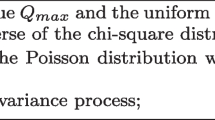Abstract
In this paper we use a stochastic programming approach to develop currency option hedging models which can address problems with multiple random factors in an imperfect market. The portfolios considered in our model are rebalanced at the end of each time period, and reinvestments are allowed during the hedging process. These sequential decisions (reinvestments) are based on the evolution of random parameters such as exchange rates, interest rates, etc. We also allow the inclusion of a variety of instruments in the hedging portfolio, including short term derivative securities, short term options, and futures. These instruments help generate strategies that provide good liquidity and low trade intensity. One of the important features of the model is that it incorporates constraints on sensitivity measures such as Delta and Gamma. By ensuring that these hedge parameters track a desired trajectory (e.g., the parameters of a target option), the new model provides investment strategies that are robust with respect to the perturbations measured by Delta and Gamma. In order to manage the explosion of scenarios due to multiple random factors, we incorporate sampling within a scenario aggregation algorithm. We illustrate that when compared with other myopic hedging methods in imperfect markets, the new stochastic programming model can provide better performance. Our examples also illustrate stochastic programming as a practical computational tool for realistic hedging problems.
Similar content being viewed by others
References
G. Barone-Adesi and R.E. Whaley, Efficient an alytic approximation of american option values, The Journal of Finance XLII(2) (1987) 301–320.
P. Boyle and T. Vorst, Option pricing in discrete time with transaction costs, Journal of Finance 47 (1992) 637–654.
S. Bradley and D. Crane, A dynamic model for bond portfolio management, Management Science 19 (1972) 139–151.
D. Carino, T. Kent, D. Myers, C. Stacy, M. Sylvanus, A. Turner, K. Watanabe and W. Ziemba, The Russell–Yasuda Kasai model: An asset/liability model for a Japanese insurance company using mul-tistage stochastic programming, Interfaces 24(1994) 29–49.
J. Cox, J. Ingersoll, and S. Ross, A theory of the term structure of interest rates, Econometrica 53 (1985) 385–407.
J. Cox, S. Ross and M. Rubinstein, Option pricing: A simplified approach, Journal of Financial Economics 7(1979) 229–263.
C. Edirisinghe, V. Naik and R. Uppal, Optimal replication of options with transactions costs and trading restrictions, Journal of Financial and Quantitative Analysis 28(1993) 117–138.
K. Frauendorfer and M. Schurle, The curse of dimensionality in stochastic multistage linear program-ming, Technical report, Workshop on Stochastic Programming, Tucson, AZ (1996).
B. Golub, M. Holmer, R. McKendall, L. Pohlman and S. Zenios, A stochastic programming model for money management, European J. of Operational Research 85(1995) 282–296.
D. Heath, R. Jarrow and A. Merton, Bond pricing and term structure of the interest rates: A new methodology, Econometrica 60(1992) 77–105.
J.L. Higle and S. Sen, Stochastic Decomposition: A Statistical Method for Large Scale Linear Pro-gramming (Kluwer Academic Publishers, 1996).
T.S. Ho and S. Lee, Term structure movements and pricing interest rate contingent claims, The Journal of Finance XLI(5) (1986) 1011–1029.
J. Hull, Options, Futures, and Other Derivative Securities(Prentice-Hall, 1993).
J. Hull and A. White, Pricing interest rate derivative securities, The Review of Financial StudiesS (1990) 573–592.
P. Kall and S.W. Wallace, Stochastic Programming(Wiley, 1994).
A.J. King and R.J-B. Wets, Epi-consistency of convex stochastic programs, Stochastics and Statistics Reports 34(1989) 83–92.
P. Klaassen, J.F. Shapiro and D.E. Spitz, Sequential decision models for selecting currency options (1990) unpublished.
R. Merton, Optimum consumption and portfolio rules in a continuous-time model, Journal of Eco-nomic Theory 3(1971) 373–413.
M. Musiela and M. Rutkowski, Arbitrage Pricing: Martingale Method in Financial Modeling(Springer-Verlag, 1997).
S. Nielsen and S. Zenios, A massively parallel algorithm for nonlinear stochastic network problems, Operations Research 41(1993) 319–337.
R. Rendleman and B. Bartter, The pricing of options on debt securities, Journal of Financial and Quantitative Analysis 15(1980) 11–24.
R.T. Rockafellar and R. Wets, Scenarios and policy aggregation in optimization under uncertainty, Mathematics of Operations Research 16(1991) 119–147.
R. Sharda and K. Musser, Financial future hedging via goal programming, Management Science 32 (1986) 933–947.
O. Vasicek, An equilibrium characterization of the term structure, Journal of Financial Economics 5 (1977) 177–188.
K. Worzel, K. Vassiadou, C. Zeniou and S. Zenios, Integrated simulation and optimization models for tracking indices of fixed-income securities, Operations Research 42(1994) 223–233.
S.A. Zenios, Financial Optimization(Cambridge University Press, 1993).
Author information
Authors and Affiliations
Rights and permissions
About this article
Cite this article
Wu, J., Sen, S. A Stochastic Programming Model for Currency Option Hedging. Annals of Operations Research 100, 227–249 (2000). https://doi.org/10.1023/A:1019296422231
Issue Date:
DOI: https://doi.org/10.1023/A:1019296422231




